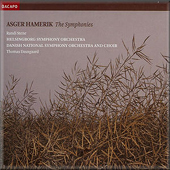
ESSENTIAL RECORDINGS

Coffrets glorieux: In 2008, Dacapo favoured us with the complete symphonies of Rued Langgaard with a six-disc set of unprecedented quality.
The cycle was re-mastered to state-of-the-art hybrid SACD (conventional stereo and super audio stereo and surround sound formats). The discs and comprehensive booklet were
housed in a deluxe flip-top box within accordion-style pop-up sleeves. It is one of those rare examples of the standard of packaging matching the artistic merit of its
contents. And now the same treatment has been extended to the seven symphonies and requiem of Asger Hamerik. The recordings were made between 1997 and 2005
in Sweden and Denmark. Collectors unacquainted with the composer can now benefit doubly from acquiring marvelous recordings of Hamerik's greatest music in its ultimate,
covetable presentation. Dedicated collectors will find that the Hamerik set, like that devoted to Langgaard, is an absolute joy to behold.
Un Danois errant: The 19th century saw a cultural revolution throughout Scandinavia in the arts. Literature, drama, landscape painting and music
all flourished in the successive waves of national identity. Denmark played a leading role in the development of nationally distinctive music apart from the central European
model. Although musical dialogue would be sustained with mainland Europe, Danes, Swedes, Norwegians and later the Finns served notice that they would follow a path apart in
composition. Asger Hamerik (1843 – 1923) became a major Danish composer – but at a distance. Hamerik received his early musical education from Niels W Gade and JPE Hartmann.
In 1862, he embarked on a grand tour of the musical capitals of Europe beginning with London. In Berlin, he studied with Hans von Bulow until war broke out between Prussia
and Denmark in 1864. Decamping to Paris, he became the sole pupil of Hector Berlioz. After the death of Berlioz in 1869, he travelled to Italy and then Vienna. It is
indicative of Hamerik's notable musicianship and conviviality that an American diplomat in Vienna engaged his services to become director of the Peabody Institute in Baltimore.
He went to America in 1871 and remained at the Peabody for 27 years. The appointment put an orchestra of eighty musicians at Hamerik's disposal. This was a larger ensemble
than anything active in Denmark at the time. Hamerik found Baltimore's music scene to be over-reliant on German repertory and he set out to compose orchestral works to balance
the programme and to fully exploit the large orchestra and develop it potential.
Dans la boite: It is worth reviewing the contents in detail because the nomenclature reveals much about Hamerik's approach to music and his methods:
Disc 1: Symphony No 1, op 29 Symphonie Poétique (1879-80)
Symphony No 2, op 32 Symphonie Tragique (1882-83)
Disc 2: Symphony No 3, op 33 Symphonie Lyrique (1883-84)
Symphony No 4, op 35 Symphonie Majestueuse (1888-89)
Disc 3: Symphony No 5, op 36 Symphonie Sérieuse (1889-91)
Symphony No 6, op 38 Symphonie Spirituelle (1897)
Disc 4: Symphony No 7, op 40 Choral Symphony (1906)
Requiem, op 34 (1886-87)
La musique, surtout la musique: Asger Hamerik remains an obscurity to many of us and the best way to correct the state of affairs is to hear the music in Dausgaard's definitive interpretations. Among major league Romantic-era contemporaries, Hamerik is closer to Dvorak than Tchaikovsky in idiom. In the Nordic division of the day, he surpasses by far the abortive symphonist Edvard Grieg, highly regarded two-timer Johan Svendsen, Johan Halvorsen and Christian Sinding. Hamerik was the best of a talented regional field and may be regarded as the missing link between Niels Gade and Carl Nielsen.
Contrary to his stated intention to compose un-German music for the Baltimore concert public, Hamerik's first two symphonies are redolent of Robert Schumann. Mind that the introductory military bugle call in Symphony No 2 goes straight to what would become one of Gustav Mahler's most prominent musical fetishes. If the first two symphonies are pleasant diversions, the rate of development in the remaining orchestral symphonies is quite phenomenal. With each succeeding composition, the contrasts become more dramatic and their large scale integration more fluid. It almost seems that Hamerik was composing to provide more complex challenges for an orchestra growing in capability and confidence. This is a rewarding cycle at every turn.
The performances are outstanding. Comparative recordings are not plentiful but while Johannes Goritski directed a very good account of Symphony No 6 (for strings) for CPO, Dausgaard really shows what can be made of the work. He brings it into the realm of Bartok's Divertimento in terms of accomplishment. Indeed, one of the fascinating things about the set is the extent to which Hamerik's themes, melodies and well-crafted phrases come through as premonitions of the best devices of composers as diverse as Elgar, Atterberg and Rachmaninov.
As fine as the first six symphonies are, the crown jewels of the set are the Choral Symphony and the Requiem. In the latter, the bold influence of Berlioz is quite evident. Text and translations are included in the booklet.
Seasonal Groan: The British comedian Alexei Sayle once remarked, "What did I get for Christmas? I got drunk." Collectors fortunate enough to receive, or otherwise acquire, this splendid set are entitled to respond deadpan to the query with, “I got Hameriked.”
Stephen Habington